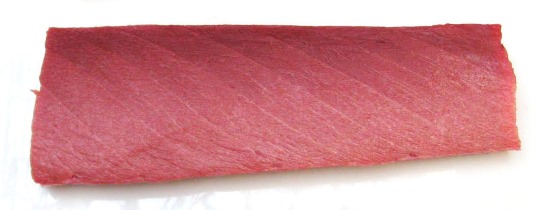Banned internationally, US retailers of sushi products continue to treat some seafood with carbon monoxide to keep it looking fresh

Is it possible that sushi vendors are using a deadly substance in order to appeal to the eyes of consumers? I could not believe it, so I researched it further.
Apparently, carbon monoxide prevents oxidation in tuna. That means that instead of going brown, fish stays bright red and fresh looking. While carbon monoxide poisoning in large amounts can and does kill hundreds every year, the FDA has ruled that treating fish and meat with the preservative is “GRAS”, or “Generally Recognized as Safe.”
Why are seafood vendors using carbon monoxide? When tuna is flash frozen, not all of the microbes are killed. The process is simply not cold enough. Because of this, tuna will go brown quite quickly. Seafood dealers found that they could preserve the cherry red coloring of the fish, making it more appealing to consumers. When your competitors are able to offer older tuna which looks as if it was just hauled out of the ocean, it becomes difficult to compete unless you join standard industry practices of hiding signs of decay with preservatives.
Even though it has been considered safe by the FDA, there are restrictions. Tuna that has been treated with the chemical additive of carbon monoxide must have the information clearly stated on its label. It cannot be marketed or branded as fresh frozen, because carbon monoxide can act as a preservative.
But can you trust the labels? While the FDA has required tuna vendors to clearly indicate the existence of carbon monoxide as a preservative, they have allowed at least two different meat vendors to use the exact same process – without labeling their product in any way. If the meat industry can get away with selling carbon monoxide treated products, I would not be surprised if things could change for seafood.
Why Carbon Monoxide In Sushi?
While carbon monoxide as a preservative is sanctioned by the US government, international response is different. In 2003 the European Union unilaterally banned the use of carbon monoxide in both meat and seafood. Their reasoning? The bright red, fresh looking coloring that carbon monoxide gives can hide harmful growth of bacteria. China, which is not known for consumer protections has also banned the use of carbon monoxide in food products. It should also come as no surprise that Japan, the sushi capital of the world, does not allow the practice.
When you see a beautiful, bright red packaged tuna, check the ingredients. If tuna has partially decomposed, adding tasteless carbon monoxide smoke can hide the fact that the fish is no longer fresh. If you are lucky, it will only be the taste that is ruined. Sushi, in its essence, depends on simplicity. If the main ingredient that the sushi roll revolves around looks beautiful but tastes fishy, the experience suffers.
Personally, I am going to be reading labels carefully. When I eat sushi, I want to feel robust and revitalized. Carbon monoxide is just not an ingredient I am comfortable putting in my body (even dietarily versus breathing it in), even if the FDA rules it as “generally considered safe.”
When you eat sushi, you are always taking a slight risk. The simple fact that you are eating raw food carries with it a higher risk because there is no cooking process to kill harmful bacteria. It is incredibly important that you use good quality, fresh ingredients. My advice? When it comes to sushi, skip the monoxide. Consumers should be allowed to pick their food using their eyes without having to worry that signs of old, decaying fish have been hiding with chemical preservatives.
I have always been fascinated by the creation and culture of different foods, particularly sushi and sashimi in the modern era of Japanese cuisine. I am a classically trained chef and sushi connoisseur, also having operated a food service company and enjoy investigating and experimenting with food around the world.
